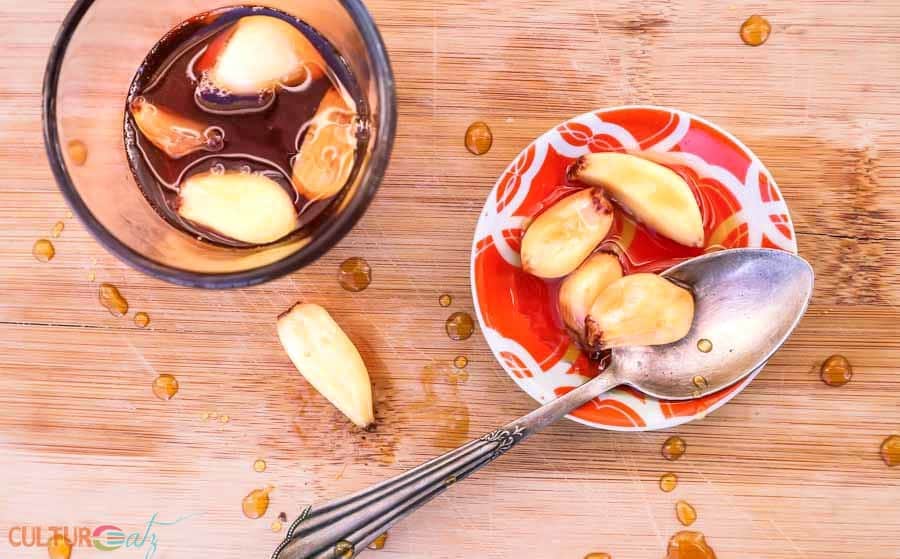
This unique Fermented Honey with Garlic recipe can be used with meats, marinades, sauces, as a throat remedy, and to make kick-ass vinaigrette.
I recently polled my Instagram followers about their opinion on the fermentation craze. Extreme answers were given: good and bad. I personally am ambivalent about it but like to try such foods and I have made a few fermented foods recipes. We act like it is a new trend but the human race has been eating fermented foods for thousands of years. But I want to ask the question: what is fermentation exactly? Let’s explore this topic together and make sure to give this Fermented Honey with Garlic Recipe a try.
Quick mention, this past June 14th was my 11th BLOGIVERSARY. Insane!!! But I decided to keep it low key this year and did not dedicate a post to it. 10 is wow, 11 is meh. But I wanted to let you know anyway.
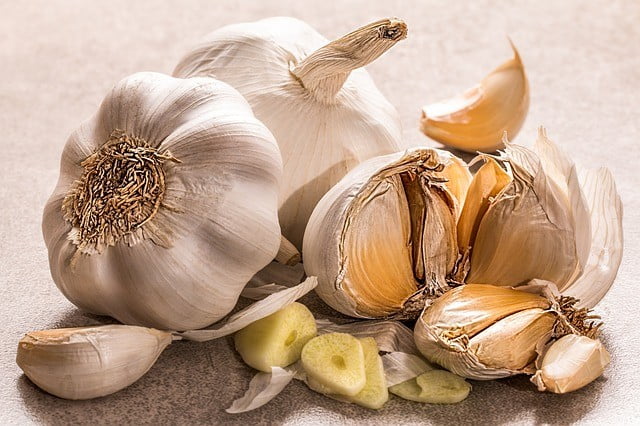
Advantages of Fermentation
So which side of the fermentation fence do you stand on? I totally agree that the trend right now for fermented food, like as if we just invented them, is a result of our #firstworldproblems society. But we as people walking on earth have been fermenting for millenniums. And like all great inventions, we fell on it by accident or coincidence.
Take alcohol which is the fermentation of sugar and a fruit, probably left in a misplaced jar. Same for cheese, beer, bread, kefir, and more. Sauerkraut and kimchi are commons dishes we associate with specific cultures but they are kings on the fermented food line.
And not only is sauerkraut good for you but it this was essential to surviving back then. Pickling was a way to extend the life of fresh food, it was a way to preserve food. In case you were wondering if pickles are fermented, the answer is yes. They had no idea back then about the sauerkraut health benefits or similar kimchi health benefits. They just knew it tasted really good and they would have food throughout the winter, that was the main purpose of fermentation.
Don’t forget to subscribe to my YouTube channel!
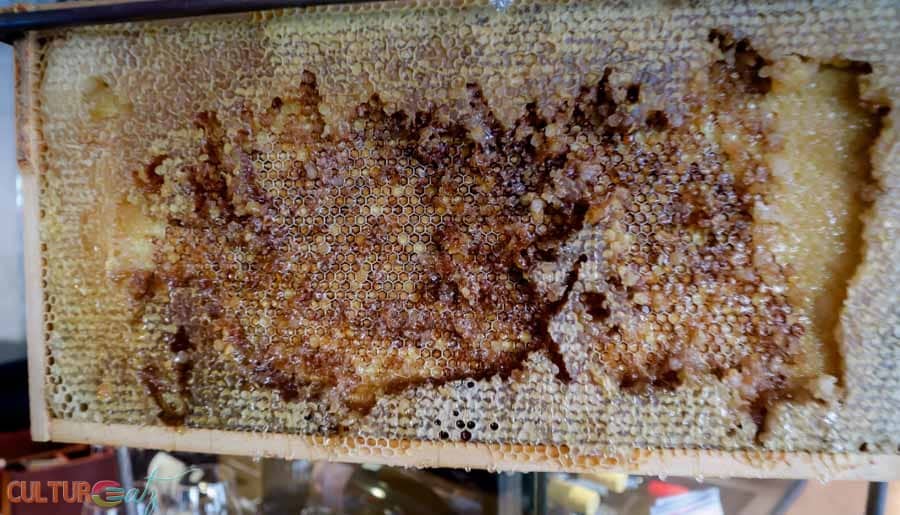
What is Fermentation?
We go on and on with our opinions about the cultured food life, natural probiotic foods, and what are fermented foods…but what does fermented mean? Do we know when does fermentation occur, or what are the conditions for fermentation? Let’s delve a little bit into the science of fermentation?
So how does fermentation work exactly? It occurs when microorganisms, like bacteria or yeast, transforms carbs like sugars into alcohol or organic acids, and when there is little access to oxygen. And do you know how many types of fermentation there is? The answer is there are two types of fermentation: alcoholic and lactic acid fermentation. Now you know what are the two types of fermentation but let’s explore a bit further.
Did you get your FREE PRINTABLE yet?
Surprise! I have prepared a Cheat Sheet that includes 41 Cooking and Baking Ingredient Substitutions that are commonly found in a kitchen. Click here to get your FREE Ingredient Substitutions Cheat Sheet right now!

What is Alcoholic Fermentation?
In the simplest terms, it is usually produced by yeast that transforms the sugars into carbon dioxide. The uses of fermentation are found in wine, beer, bread.
What is Lactic Acid Fermentation?
For this fermentation to occur you need the presence of lactic acid bacteria, also known as lactobacillus, often found in the best probiotic foods. This is basically the type used on how to ferment vegetables as well. Examples of what is what is fermented this way is yogurt, kefir, sauerkraut, and kimchi.
And some of the best fermented foods are products of both types of fermentation. Alcoholic and lacto fermented foods include sourdough bread and the fermented honey and garlic recipe found below.
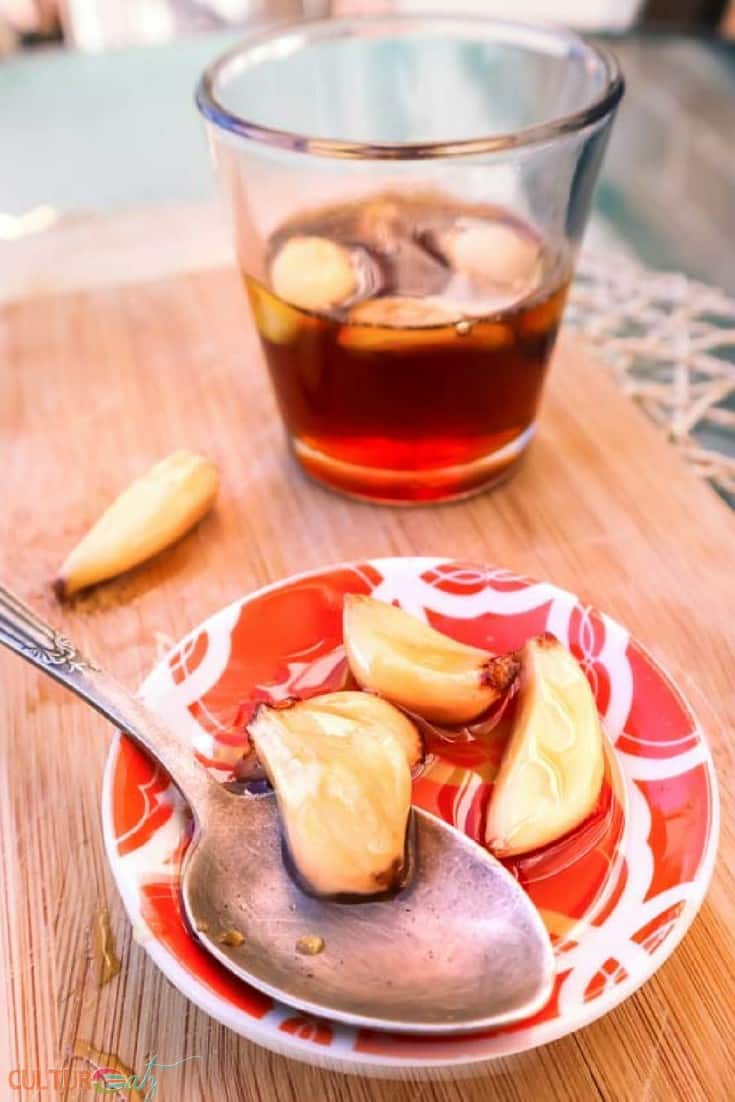
Fermented Foods List
Here is a very short list of fermented food products:
- kefir
- sourdough starter for bread
- kombucha
- sauerkraut
- tempeh
- Chinese Laba garlic
- miso
- natto
- Uji, a Kenyan Fermented Porridge
- pickled vegetables
- kimchi
- yogurt
- kvass
- Polish White Borscht Soup
- these are just a few examples of fermented foods, check out the huge list here
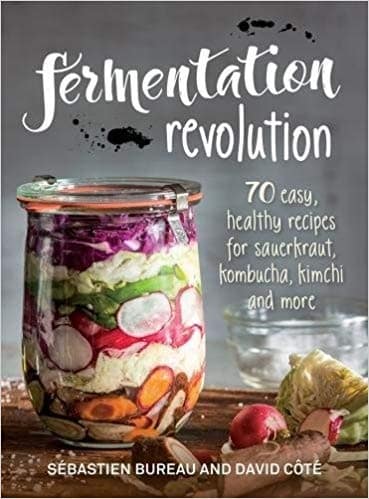
I got this recipe from the cookbook Fermentation Revolution 70 easy recipes for sauerkraut, kombucha, kimchi and more by Sébastien Bureau and David Côté. The authors actually reside in my city of Montreal and are pioneers of raw food restaurants and kombucha products here.
There is an impressive array of recipes to be found in this cookbook, such as pickled cucumbers, kimchi, chunky chutney, Bajan hot pepper sauce, water kefir, kombucha, apple cider, almond yogurt, beer, tempeh, sake, miso, to name a few. Some recipes require some sort of a starter but they also advise on where to buy them.
Click here to get the bookDisclosure: this cookbook was sent to me by robertrose.ca. All opinions are 100% my own and honest.
Benefits of Fermented Foods
And now we get to the heart of the whole fermented food debate: are fermented foods good for you? And if so, why are fermented foods good for you? There is no question as to the importance of fermentation as far as it being a food preservation technique, but are what are the health benefits of fermented foods…
- soothes and improves digestion: fermentation breaks down complex nutrients making them easier to be digested and absorbed. So they are foods good for digestion.
- improves your central nervous systems: via the vagus nerve which is connected to the nervous system of the intestines.
- stimulates the immune system: our immune system is closely related to the gut, so a healthy gut means better health.
- regulates your metabolism: with a happier gut and the fact that fermented foods can control your blood sugar, it can help to improve your metabolism.
- some studies claim that some fermented probiotic foods can help prevent cancer, arthritis, bowel disorders and hepatic disease. Good bacteria foods can be the best foods for gut health.
Don’t forget to subscribe to my YouTube channel!
Garlic and honey benefits
Now we know how healthy fermented foods work and we get added help with this recipe. Garlic boosts the immune system and honey for throat soreness is an age-old remedy. This fermented garlic and honey remedy is great to have when you have a cold. I have drunk garlic and honey for cough (in a cup of hot water) for years when I have been sick and it is one of the best natural sore throat remedies.
Are all these benefits for real? There is no one-time miracle cure. Everything should be eaten with moderation and I believe fermented foods work if you eat a little on a very regular basis. Its just part of a well-balancedd diet.
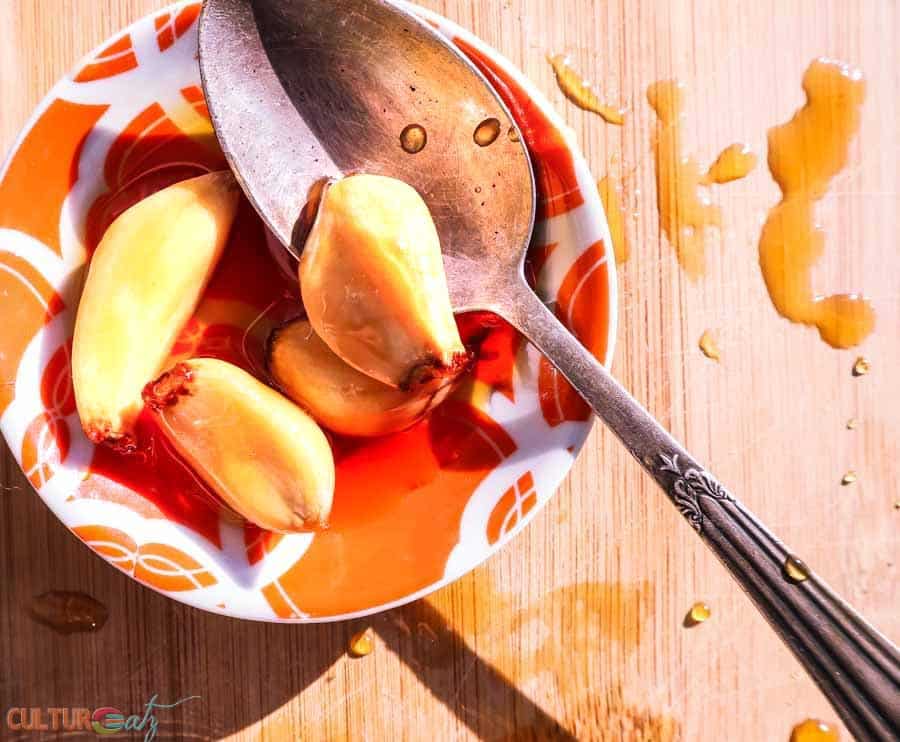
Fermented Honey with Garlic Recipe
Many people feel overwhelmed by the thought of fermenting their own food. But fermenting doesn’t have to be complicated. That is why I chose this simple fermented garlic honey to get you started. It is so simple and you get a multi-use condiment out of it to boot.
All you need is a jar, raw garlic and honey, and 1 month. The initial prep – of peeling the garlic- takes about 15 minutes. After that, you will need about 30 seconds a day for the first 2 weeks. And then for the last 2 weeks, there is nothing to do. You will know it is ready when the garlic cloves get a bit brown and the honey will be more liquid.
Honey and garlic is such a classic flavor combo when it comes to cooking. You will come up with a million uses for this fermented garlic and honey recipe. Here are a few ideas:
- as a marinade for meats and vegetable
- use when making sauces
- drizzle over a grilled salmon steak
- make kick-ass vinaigrette with this honey
- chop up the garlic cloves and add to any dish or salads
- add to a cup of hot water

Fermented Honey with Garlic
Ingredients
- 1 cup of garlic cloves
- 3/4 cup unpasteurized honey
Instructions
- Peel garlic cloves. Discard any cloves that are damaged or brown. Place garlic cloves in a glass jar and cover with honey. use a weight to keep garlic cloves submerged. Seal airtight.
- Let ferment a room temperature. For the first 2 weeks, gently shake the jar every day to thoroughly mix honey with the liquid released from the garlic and to submerge stray garlic cloves. During the first week, every 2 days, released the gasses that have accumulated by slightly unscrewing the ring of the jar for a few seconds, then sealing airtight.
- Let stand for another 2 weeks. By then, the honey will have turned much more liquid, almost like water.
- Keeps for one year at room temperature. Use in savory recipes that require a sweetener, use to make vinaigrettes, have a teaspoon to help a sore throat. Use garlic cloves in recipes.
Notes

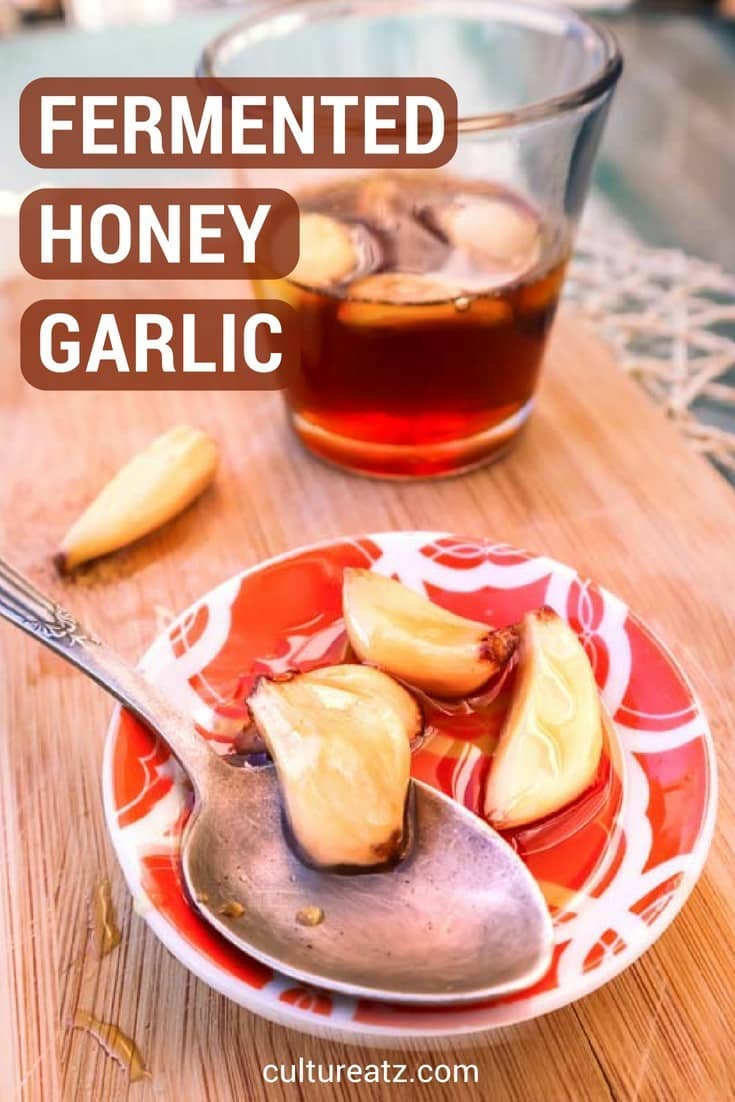



Fermented honey and garlic sounds like a great combination! It would be great to add this to all sorts of things.
It is so great for sure and can be used in so many recipes!
My blog becomes 10 in November! Quite some time ha? Happy blogiversary, to many years to come! I haven’t heard about this latest trend. Thanks for all the info. I love garlic and I love honey so this looks wonderful!
Wow you will have a big milestone soon Katerina! Yep, a long time but flies by too. This is a great recipe, hope you try it!
Great post and happy Blogiversary! 11 years is a great achievement. I am a real fan of fermented foods and their benefits. I’ve been making Kimchi and have a great sourdough starter on the go! I love the sound of the garlic and honey recipe, I am going to try this!
Thank you for the congrats, wow yep 11 years. Oh do you have a kimchi recipe to share? It’s on y bucket list. You will love this recipe I think. And you could add a bit of this honey to a sourdough bread too!
First of all Happy 11th BLOGIVERSARY.. YAAAAy .. Wow 11 years.. girl you rock! This is such a wonderful and informative post that I need to read more than once, I’ve tried pickling before and I am trying to accept kimchi in my diet after what I’ve heard about.. so healthy. This recipe is a must try for me that hard part is waiting :). Thanks for such a lovely post.
Thank you so much Amira, my friend. And so glad you liked this post so much. I suggest making a good quantity so once you do wait out the first month, you’ll then be good for a while. I can so picture drizzling this on some of your savory pastries!
I think dosas and idlis are the only things I’ve ever had in fermented form. 🙂
This looks lovely – I should try it out!
Now I am craving dosas and idlis lol. This honey garlic fermentation is totally worth a try!
Wow! I had no idea you can fermented things in honey! I must give this a try! Thanks for sharing. x
I know I was shocked to Su, very cool recipe, so delicious, and so many uses. Hope you enjoy.
This is interesting. I’m a huge fan of fermented foods but I’ve never heard of fermented honey before. The closest I’ve come would be a “hot honey” that I’ve had with some chili infused in the honey…yum.
How do you know if the honey is pasteurized? I usually buy from my local farmer’s markets and it’s not something I’ve ever heard mentioned. I will have to ask and see what they say.
Thanks Malini for dropping by! Oh hot honey sounds great! Honestly “pasteurized” is what the official recipe says, I used what I had at home and it worked fine. I think honey from a local farmer’s markets is just fine. Let me know what they say.
I have never heard of this before! Totally intrigued now. 🙂
I was also surprised when I saw the recipe, great and easy way to try fermentiing at home.
I rarely eat fermented foods, but I know that they are really good for you. I like garlic and honey and so this would be a good place for me to start. Thanks so much!
I don’t as much as I should either, this recipe is a great and easy way to try fermenting at home.
Happy 11th! And heck, if 10 is WOW! then 11 must be WOW! WOW! 🙂 Anyway, I like the idea of fermented stuff — have always enjoyed pickles and relishes and stuff like that. I don’t go out of my way to make fermented things, mind you, but I like it. And I know I’d like this! Good recipe, and really interesting post — most enjoyable read. Thanks.
Thank you for the bb wishes 🙂 yeah lots of fermented recipes seems so complicated but this one is so easy, worth trying. So glad you liked the read John.
I am definitely a garlic girl. Garlic for the win. However, I only eat it really when I go out to eat and it’s included in recipes. Probably because I am super minimalistic when it comes to making my meals meals (not recipes for blog necessarily) and just like everything PLAIN, even salads! ha!
Not sure how to put a SHOCKED FACE emoji from a laptop comment…I would SMOTHER YOU in spices and condiments for saying that lol. I do enjoy salads plain thought too.
I Totally love these kinds of vinaigrette, sweet!
Well, first you have to make the fermented honey 🙂 But yes I like a little sweet touch to them too.
Oooh, I’m intrigued! I love the idea of adding this honey to a vinaigrette!!
I think you would love this honey and a few chopped cloves for your vinaigrette. And you do not need a kitchen for this recipe!
:-)) I have a couple of bottles in the cupboard and we eat one each day. They taste so mellow and delicious, don’t they? The honey is so good on the sourdough bread too.
I am not surprised you have some. yes so mellow, I added some to my cold spaetzle salad, so good and yes mellow. Oh will have to add some next time I make bread. Not now 44C with humidity! 🙁